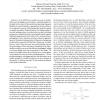Free Online Productivity Tools
i2Speak
i2Symbol
i2OCR
iTex2Img
iWeb2Print
iWeb2Shot
i2Type
iPdf2Split
iPdf2Merge
i2Bopomofo
i2Arabic
i2Style
i2Image
i2PDF
iLatex2Rtf
Sci2ools
ASPDAC
2006
ACM
2006
ACM
Crosstalk analysis using reconvergence correlation
Abstract— In the UDSM era, crosstalk is an area of considerable concern for designers, as it can have a considerable impact on the yield, both in terms of functionality and operating frequency. Methods of crosstalk analysis are pessimistic in nature and the effort is ongoing to come up with techniques that make the analysis as realistic as possible. Using information from timing analysis is one such technique where we use data about overlap in switching among nets to identify those that can potentially switch together. Existing techniques tend to look at the set of a victim and associated aggressor nets in isolation, and select a subset of aggressors based on the absolute timing windows of these nets, thus ignoring the information associated with the fanin of these nets. In reality, however, some of these nets may never switch together because the reconvergence of those nets has not being factored in. Ignoring this correlation can cause false failures being flagged, leading to incre...
| Added | 13 Jun 2010 |
| Updated | 13 Jun 2010 |
| Type | Conference |
| Year | 2006 |
| Where | ASPDAC |
| Authors | Sachin Shrivastava, Rajendra Pratap, Harindranath Parameswaran, Manuj Verma |
Comments (0)

